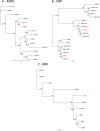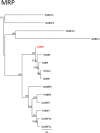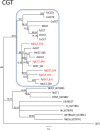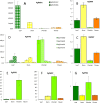Antinutritional factors in pearl millet grains: Phytate and goitrogens content variability and molecular characterization of genes involved in their pathways - PubMed (original) (raw)
Antinutritional factors in pearl millet grains: Phytate and goitrogens content variability and molecular characterization of genes involved in their pathways
Eleonora Boncompagni et al. PLoS One. 2018.
Abstract
Pearl millet [Pennisetum glaucum (L.) R. Br.] is an important "orphan" cereal and the most widely grown of all the millet species worldwide. It is also the sixth most important cereal in the world after wheat, rice, maize, barley, and sorghum, being largely grown and used in West Africa as well as in India and Pakistan. The present study was carried out in the frame of a program designed to increase benefits and reduce potential health problems deriving from the consumption of pearl millet. The specific goal was to provide a database of information on the variability existing in pearl millet germplasm as to the amounts of phytate, the most relevant antinutrient compound, and the goitrogenic compounds C-glycosylflavones (C-GFs) accumulated in the grain.Results we obtained clearly show that, as indicated by the range in values, a substantial variability subsists across the investigated pearl millet inbred lines as regards the grain level of phytic acid phosphate, while the amount of C-GFs shows a very high variation. Suitable potential parents to be used in breeding programs can be therefore chosen from the surveyed material in order to create new germplasm with increased nutritional quality and food safety. Moreover, we report novel molecular data showing which genes are more relevant for phytic acid biosynthesis in the seeds as well as a preliminary analysis of a pearl millet orthologous gene for C-GFs biosynthesis. These results open the way to dissect the genetic determinants controlling key seed nutritional phenotypes and to the characterization of their impact on grain nutritional value in pearl millet.
Conflict of interest statement
The authors have declared that no competing interests exist.
Figures
Fig 1. Distribution of phytate and total phosphate among 145 pearl millet lines from a panel of inbred lines covering a large genetic diversity.
Phytic acid phosphorus (PAP, blue line), total phosphorus (Ptot, red line), ratio of phytic acid content to total phosphorus (PAP/Ptot,, violet line) and Pi (green line). Red dots and boxes indicate the most contrasting lines for phytic acid content.
Fig 2. Distribution of phytic acid content, total phosphorus and inorganic phosphate in the grains of the first and second generations of inbred lines contrasting for phytic acid and total C-GFs content.
ICML157032, lpa and hcgf and ICML157101, hpa and lcgf. Each data is the mean of two biological replicates.
Fig 3. Distribution of C-GFs content among the grains of 96 pearl millet lines from a panel of inbred lines covering a large genetic diversity.
Red arrowheads indicate the most contrasting lines, ICML157013 and ICML15711, having the highest and lowest C-GFs content, respectively. Red boxes and arrows indicate the two inbred lines selected for their contrasting content of phytic acid. Each bar is the sum of the content of each C-GF (vitexin, yellow; glucosyl vitexin, orange; rhamnosyl vitexin, dark red; orientin, light green; glucosyl orientin, green; rhamnosyl orientin, blue) in each line.
Fig 4. HPLC chromatogram showing the peaks of the different C-GFs identified in pearl millet grains.
Fig 5. Distribution of the different C-GFs in the grains of the first and second generations of inbred lines contrasting for phytic acid and total C-GFs content.
ICML157032, lpa and hcgf and ICML157101, hpa and lcgf. Data are the mean of two biological replicates.
Fig 6. Percentage contribution of each C-GF to the total C-GFs contained in the grains of 96 pearl millet lines from a panel of inbred lines covering a large genetic diversity.
Vitexin, yellow; glucosyl vitexin, orange; rhamnosyl vitexin, dark red; orientin, light green; glucosyl orientin, green; rhamnosyl orientin, blue.
Fig 7. Neighbour-joining trees inferred from the deduced amino acid sequence of early phytic acid pathway genes identified in pearl millet.
(A) MIPS, (B) IMP, (C) MIK. Bars indicate the number of amino acid substitutions per site. Sequences IDs are reported in S2 Table.
Fig 8. Neighbour-joining trees inferred from the deduced amino acid sequence of intermediate-late phytic acid pathway genes identified in pearl millet.
(A) ITPK, (B) IPK2, IPK1 (C). Bars indicate the number of amino acid substitutions per site. Sequences IDs are reported in S2 Table.
Fig 9. Neighbour-joining trees inferred from the deduced amino acid sequence of MRP phytic acid transporter gene identified in pearl millet.
Bars indicate the number of amino acid substitutions per site. Sequences IDs are reported in S2 Table.
Fig 10. Neighbour-joining trees inferred from the deduced amino acid sequence of CGT gene identified in pearl millet.
Bars indicate the number of amino acid substitutions per site. Sequences IDs are reported in S2 Table.
Fig 11
Expression analysis by quantitative RT-PCR of genes involved in phytic acid (A-L) and C-GFs (M) pathway in developing seeds of the two inbred lines contrasting for their content of phytic acid and C-GFs (ICML157032_lpa_hcgf and ICML157101_hpa_lcgf). Colour of the bars indicate different seed developmental stages: yellow, 5–8 DAF; orange, 9–14 DAF; brown, 15–21 DAF. Striped bars indicate ICML157032_lpa_hcgf line, dashed bars indicate ICML157101_hpa_lcgf line. (A) expression of PglMIPS_337 and PglMIPS_896; (B) expression of PglITPK_602; (C) expression of PglMRP; (D) expression of PglIMP; (E) expression of PglMIK; (F) expression of PglITPK_980; (G) expression of PglITPK_775; (H) expression of PglITPK_425; (I) expression of PglIPK1; (L) expression of PglIPK2; (M) expression of PglCGT_646 and PglCGT_648. Samples at early stage of seed development were used as calibrators.
Fig 12. Expression analysis by quantitative RT-PCR of genes involved in phytic acid pathway in leaves, stems, plantlets and anthesis flowers of the reference line SDEB4L-160P6.
Color of the bars indicate different organs: dark green, leaf; yellow, stem; light green, plantlet; orange, flower. (A) expression of PglMIPS_337 and PglMIPS_896; (B) expression of PglMIK; (C) expression of PglIMP; (D) expression of PglITPK_980, PglITPK_602, PglITPK_425 and PglITPK_775; (E) expression of PglIPK1; (F) expression of PglMRP; (G) expression of PglIPK2. Leaf samples were used as calibrators.
Fig 13. Scheme representing the two branches of C-GFs biosynthesis in pearl millet.
The aglycone (either apigenin or luteolin) is converted to orientin or vitexin. These C-GFs than can be further glycosylated resulting in the production of corresponding glucosylated o rhamnosylated forms. Arrows indicate significant correlations (p<0.01), green lines and plus symbol correspond to positive correlation, red lines and minus symbol indicate a negative correlation. The size of plus and minus symbols indicate the strength of the correlation, as reported in Table 3.
Similar articles
- Cereal domestication and evolution of branching: evidence for soft selection in the Tb1 orthologue of pearl millet (Pennisetum glaucum [L.] R. Br.).
Remigereau MS, Lakis G, Rekima S, Leveugle M, Fontaine MC, Langin T, Sarr A, Robert T. Remigereau MS, et al. PLoS One. 2011;6(7):e22404. doi: 10.1371/journal.pone.0022404. Epub 2011 Jul 22. PLoS One. 2011. PMID: 21799845 Free PMC article. - Phylogeny and origin of pearl millet (Pennisetum glaucum [L.] R. Br) as revealed by microsatellite loci.
Oumar I, Mariac C, Pham JL, Vigouroux Y. Oumar I, et al. Theor Appl Genet. 2008 Aug;117(4):489-97. doi: 10.1007/s00122-008-0793-4. Epub 2008 May 27. Theor Appl Genet. 2008. PMID: 18504539 - Morpho-biochemical characterization and molecular marker based genetic diversity of pearl millet (Pennisetum glaucum (L.) R. Br.).
Gunguniya DF, Kumar S, Patel MP, Sakure AA, Patel R, Kumar D, Khandelwal V. Gunguniya DF, et al. PeerJ. 2023 Jun 5;11:e15403. doi: 10.7717/peerj.15403. eCollection 2023. PeerJ. 2023. PMID: 37304873 Free PMC article. - Potential use of pearl millet (Pennisetum glaucum (L.) R. Br.) in Brazil: Food security, processing, health benefits and nutritional products.
Dias-Martins AM, Pessanha KLF, Pacheco S, Rodrigues JAS, Carvalho CWP. Dias-Martins AM, et al. Food Res Int. 2018 Jul;109:175-186. doi: 10.1016/j.foodres.2018.04.023. Epub 2018 Apr 18. Food Res Int. 2018. PMID: 29803440 Review. - Pearl Millet: A Climate-Resilient Nutricereal for Mitigating Hidden Hunger and Provide Nutritional Security.
Satyavathi CT, Ambawat S, Khandelwal V, Srivastava RK. Satyavathi CT, et al. Front Plant Sci. 2021 Sep 13;12:659938. doi: 10.3389/fpls.2021.659938. eCollection 2021. Front Plant Sci. 2021. PMID: 34589092 Free PMC article. Review.
Cited by
- Genetic and genomic interventions in crop biofortification: Examples in millets.
Kudapa H, Barmukh R, Vemuri H, Gorthy S, Pinnamaneni R, Vetriventhan M, Srivastava RK, Joshi P, Habyarimana E, Gupta SK, Govindaraj M. Kudapa H, et al. Front Plant Sci. 2023 Mar 6;14:1123655. doi: 10.3389/fpls.2023.1123655. eCollection 2023. Front Plant Sci. 2023. PMID: 36950360 Free PMC article. Review. - Phytic Acid and Transporters: What Can We Learn from low phytic acid Mutants.
Cominelli E, Pilu R, Sparvoli F. Cominelli E, et al. Plants (Basel). 2020 Jan 5;9(1):69. doi: 10.3390/plants9010069. Plants (Basel). 2020. PMID: 31948109 Free PMC article. Review. - Acceptance and Impact of Millet-Based Mid-Day Meal on the Nutritional Status of Adolescent School Going Children in a Peri Urban Region of Karnataka State in India.
Anitha S, Kane-Potaka J, Tsusaka TW, Tripathi D, Upadhyay S, Kavishwar A, Jalagam A, Sharma N, Nedumaran S. Anitha S, et al. Nutrients. 2019 Sep 3;11(9):2077. doi: 10.3390/nu11092077. Nutrients. 2019. PMID: 31484377 Free PMC article. - Gluten-Free Cereals and Pseudocereals as a Potential Source of Exposure to Toxic Elements among Polish Residents.
Bielecka J, Markiewicz-Żukowska R, Puścion-Jakubik A, Grabia M, Nowakowski P, Soroczyńska J, Socha K. Bielecka J, et al. Nutrients. 2022 Jun 3;14(11):2342. doi: 10.3390/nu14112342. Nutrients. 2022. PMID: 35684142 Free PMC article. - The Impact of Cereal Grain Composition on the Health and Disease Outcomes.
Garutti M, Nevola G, Mazzeo R, Cucciniello L, Totaro F, Bertuzzi CA, Caccialanza R, Pedrazzoli P, Puglisi F. Garutti M, et al. Front Nutr. 2022 May 25;9:888974. doi: 10.3389/fnut.2022.888974. eCollection 2022. Front Nutr. 2022. PMID: 35711559 Free PMC article. Review.
References
- Food and Agriculture Organization of the United Nation; 2016. FAOSTAT Database. Available from: http://www.fao.org/faostat/en/#data/.
- Food and Agriculture Organization of the United Nation; 2014. FAOSTAT Database. Available from: http://www.fao.org/faostat/en/#data.
- Yadav HP, Gupta SK, Rajpurohit BS, Pareek N. Pearl Millet In: Singh M., Kumar S, editors. Broadening the Genetic Base of Grain Cereals. Springer, New Delhi; 2016. pp. 205–224. doi: 10.1007/978-81-322-3613-9_8 - DOI
- Andrews DJ, Kumar KA. Pearl millet for food, feed and forage. Adv Agron. 1992; 48: 89–139. doi: 10.1016/S0065-2113(08)60936-0 - DOI
- Klopfenstein CF, Hoseney RC. Nutritional properties of sorghum and the millets: chemistry and technology In: Dandy DAV, editor. Sorghum and millets: chemistry and technology. St. Paul, MN: American Association of Ceral Chemists; 19995. pp. 125–168.
Publication types
MeSH terms
Substances
LinkOut - more resources
Full Text Sources
Other Literature Sources
Medical












